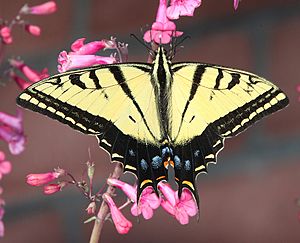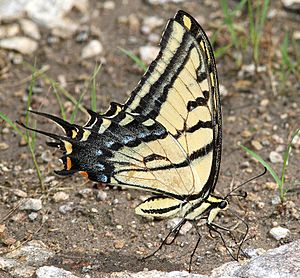Two-tailed swallowtail facts for kids
Quick facts for kids Two-tailed swallowtail |
|
|---|---|
 |
|
| Scientific classification | |
| Subspecies | |
|
Three, see text |
|
| Synonyms | |
|
Papilio multicaudatus |
The Papilio multicaudata, also known as the two-tailed swallowtail, is a beautiful butterfly. It belongs to the swallowtail family and lives in western North America. You can find it from British Columbia in Canada all the way down to Central America.
What Does It Look Like?
The two-tailed swallowtail is a large butterfly. It has bright yellow wings with bold black stripes, just like a tiger! This is why it's sometimes called a "tiger swallowtail." On each of its back wings, you'll see pretty blue markings.
It also has a small orange spot near the bottom of each back wing. This spot looks a bit like an eye. This "eyespots" can trick animals that want to eat the butterfly. The predator might attack the wrong end, giving the butterfly a chance to fly away!
This butterfly looks a lot like the western and eastern tiger swallowtails. However, the two-tailed swallowtail has thinner black stripes. It also usually has two "tails" on each back wing, instead of just one. Most two-tailed swallowtails have a black "pupil" in their orange eyespot, which helps tell them apart from the western tiger swallowtail.
It is often bigger than other similar swallowtails in its area. Its wings can spread from about 3 to 6.5 inches (7.5 to 16.5 cm). This makes it the largest swallowtail in western North America! Female butterflies are usually bigger and have brighter blue and orange colors on their back wings than males.

You can spot this butterfly in many places. Its home ranges from Guatemala and Mexico through the western United States. It even reaches southern Canada, including parts of British Columbia, Alberta, and southwestern Saskatchewan. These butterflies often live near streams and in damp valleys. They can also be found in canyons and even in cities at lower elevations.
The caterpillars of the two-tailed swallowtail eat leaves from certain plants. These "host plants" include chokecherry, bitter cherry, Arizona rosewood, and hoptree. In California, they mostly eat California hoptree. In other western areas, they often use green ash trees planted along city roads.
The two-tailed swallowtail is special because it is the state butterfly of Arizona.
Life Cycle
Adult two-tailed swallowtail butterflies fly during the spring and summer months. They usually have one group of babies (brood) each year. The female butterfly lays her eggs one by one on a host plant.
When a caterpillar hatches from an egg, it starts to eat the plant's leaves. The caterpillar is clever! It folds the leaves of the host plant and ties them together with silk. This creates a safe little shelter for it to eat inside.
After the caterpillar grows big enough, it turns into a pupa. This pupa will stay hidden through the winter. Then, in May, a new adult butterfly will emerge from the pupa, ready to fly and start the cycle all over again!
Subspecies
There are a few different types, or "subspecies," of the two-tailed swallowtail. They are found in different areas:
- P. m. grandiosus is found in the mountains of Mexico.
- P. m. multicaudata is a common type found from southern Colorado, through New Mexico, Arizona, Texas, and much of Mexico.
- P. m. pusillus is a widespread northern type. It lives in the Rocky Mountains from southern Colorado up to Canada. You can also find it throughout Washington and Oregon, and along the Pacific Coast in California.
See also
 In Spanish: Papilio multicaudata para niños
In Spanish: Papilio multicaudata para niños


